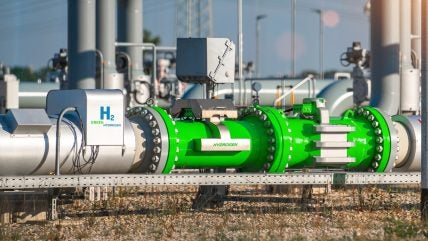
Chile is looking to attract investors in solar, wind and green hydrogen technologies as the country prepares to decarbonise its copper mines and other industries that rely on fossil fuels.
A delegation of Chilean businesspeople led by Marcos Kulka, CEO of H2Chile – a hydrogen association of 102 public and private companies – travelled to Europe to outline the country’s energy strategy, reported AFP on 12 February.
Speaking on the sidelines of the Hyvolution energy trade show in Paris, Kulka said he believes Chile can become carbon neutral by 2040 – ten years earlier than the global net-zero target – given its resources.
One way would be for Chilean officials to ramp up investment in green hydrogen technologies, he suggested. Green hydrogen results from the renewables-powered splitting of water molecules; it can be a cleaner alternative to burning natural gas or other fossil fuels.
However, the next few years are expected to be slow in terms of expanding green hydrogen projects. The International Energy Agency (IEA) now forecasts that just 7% of announced renewables capacity for green hydrogen production will be operational by 2030.
Nevertheless, Kulka believes Chile “could become one of the cheapest hydrogen producers in the world”. The government plans to shut down coal-fired plants by 2040, which, as of 2022, were responsible for 11.30% of Chile’s energy consumption. On the other hand, wind, solar and other renewable energy sources only accounted for 6.77% of total energy demand, IEA data shows. Hydrogen came last, with only 73,551 terajoules equivalent (or 4.70%) consumed in 2022 as a whole.
From a foreign direct investment (FDI) perspective, the number of greenfield projects in Chile’s green energy sector has fluctuated significantly over the past five years. According to GlobalData’s FDI Database, renewable and alternative power projects steadily increased from 20 in 2019 to 36 in 2021 before dropping to 30 in 2022 and 18 in 2023.
The Chilean delegation’s visit to Europe comes at a time when Spain, Italy and the UK are the key source markets for renewables investments in Chile. “Solar is the leading renewables sub-sector. It accounts for just over half of all renewable energy projects into Chile, followed by onshore wind,” says Glenn Barklie, head of FDI services at GlobalData. The largest renewables investor from Europe is Italian energy giant Enel.
Francesca Gregory, a senior energy transition analyst at GlobalData, says Chile is in an “enviable position” when it comes to renewable adoption since it has a “strong hydropower base, as well as optimal solar and wind conditions,” which, in 2023, accounted for nearly 65% of the country’s cumulative power production capacity.
“Chile’s renewables are set to grow further and are expected to reach 86% of total [installed] capacity by 2035,” Gregory explains. “The continuation of this growth trend makes the prospect of achieving carbon neutrality by 2040 feasible.”
However, changing patterns in weather might be an obstacle to expanding Chile’s hydropower generation. According to a report published by the World Bank in 2021, hydroelectric power output might fall by 11% by mid-century and 22% by the end of the century as a result of declining rainfall and snow in the country. Because of that, Gregory expects a 2.5% CAGR increase in natural gas capacity between 2023 and 2035.
Despite the mixed outlook for hydropower, the government in Santiago has stepped up efforts to attract investment in green hydrogen production. At the moment, the country has 62 projects in the pipeline. Once completed, they will boost Chile’s production capacity to 3.7 million tonnes per annum by 2030, upending the country’s minor player role in terms of active capacity.
“Upcoming projects with announced capital expenditures account for $2.9bn worth of investment. Long-term offtake agreements and strategic partnerships between Chile and key demand sectors in Europe will be pivotal for financing the scaling of Chile’s domestic green hydrogen economy,” Gregory says.



